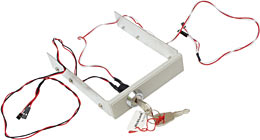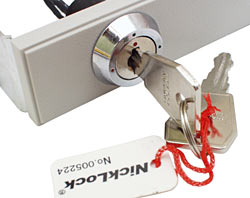
NickLock hard drive switcher
Review date: 25 April 2002.Last modified 03-Dec-2011.
Change a computer's hard drive, and you can change its personality.
The stuff in the BIOS stays the same when you swap drives, but everything from there on can change. This is handy for anybody who, for whatever reason, wants to run multiple operating systems on one computer, or have one computer for them and one for the kids all in the one box.
You can do a de facto hard drive swap by making multiple partitions on one drive and then using one or another flavour of boot manager. And it's possible to run one OS within another with emulation software. And if all you want is to keep different users out of each others' sandpits, then WinNT-series operating systems (including Win2000 and WinXP) can do proper user separation. But consumer hard drives are so cheap these days that it's really not a big deal to have more than one. Provided you've got some reasonably elegant way to switch between them.
You can leave the side of the case off and physically plug and unplug drives, but that's a pain, not to mention a welcome mat for problems with bent pins and static damage. And anybody can replug a drive that you'd rather they didn't use, and play havoc with it.
Alternatively, you can use something like this.
The NickLock is a hard drive switcher which ought to work elegantly with quite a lot of drives.
It's a simple enough gadget. A three-position keyswitch is connected to two cables...
...each of which terminates in a pair of parallel-wired two pin plugs, one with the standard 1/10th inch pin spacing that's used by most PC jumper blocks, and one with slightly tighter spacing, presumably for compatibility with smaller form factor drives.
The switch is mounted on a frame that screws into any 3.5 inch drive bay with a front panel opening.
After you've screwed the NickLock frame into a drive bay, you just hook the appropriate plug up to the Master jumper location on each of your drives, and you're in business.
The lock-switch isn't of Fort Knox quality, but it's better than the similar wafer-tumbler locks in the filing cabinets at my last office. When I tried to pick one of them, the lock barrel fell out in my hand. The NickLock barrel, at least, stays where it's meant to be.
With the lock in the centre position, both "jumpers" are open circuit, both drives don't think they've got any jumpers on their ID-select block, and neither is visible to the system.
The other two switch positions each close the circuit on one of the NickLock cables, which sets the appropriate drive to Master, making it visible. Well, as long as the appropriate IDE location is set to auto-detect in the BIOS setup, anyway.
To use the NickLock, you select the drive you want before you turn the computer on. If you power up with the NickLock set to the middle position, neither NickLock-ed drive will show up. So if the computer doesn't have something else to boot from, it won't start. It's not exactly ironclad security, but it'll stop the casual inquirer.
The NickLock depends, for correct operation, on drives that don't show up if they've got no jumpers connected. That's not, generally, likely to be a problem, I think. As far as I know, practically all vaguely modern ATA drives work that way.
Western Digital drives are an exception. With no jumper, they're in "Single Drive" mode, in which they behave as a master, but won't work at all if there's more than one device on their cable. You can apparently use them with the NickLock, by putting two WD drives on the one cable and putting the NickLock plugs on the drives' slave jumper spot, not the master one.
Hooking the drives up isn't too tricky, either.
For drives using Ultra DMA 33 or slower, you can put both drives on one cable and everything'll work. If your drives are 80-wire-cable units that use UDMA/66 or higher, however - and they probably are, these days - then the master drive on a cable should always be on the cable's end connector. A single UDMA/66 or higher drive may work fine on the middle connector of a cable, or it may not.
The easy way to NickLock-switch between two UDMA/66+ capable drives is to put them both on one 40 wire cable, which'll force them back to UDMA/33 mode. Since you'll only be using one drive at a time, and few ATA drives can saturate even UDMA/33 bandwidth, this isn't really a problem.
If you simply must use the things with 80 wire cables, though, you may be able to plug them in using two cables, one from your motherboard's first IDE connector and one from the second, with a drive on the end of each cable.
If you've got other ATA devices - like your CD-ROM drive, for instance - then putting them on the middle connector of one or both of these cables and leaving them set to slave should work. I think.
Most modern motherboards can deal with a single slave drive on a cable, which is what they'll see if you NickLock-disable the hard drive on the end of the CD-ROM drive's cable. The motherboard just automatically treats the masterless slave drive as a master, and gets on with the job of booting.
Going with two cables shouldn't foul up your boot process, either (he said, looking shifty, not having tried it), since drive letters are assigned to hard drive partitions before they're assigned to ATAPI devices like CD-ROM and DVD-ROM drives. So you should still be able to boot, even if the only visible hard drive is on IDE channel 2.
That's the story I'm sticking to until someone contradicts me, anyway.
Frankly, I'd just use a 40 wire cable. That'll just work, and the speed difference, if there is one at all, is likely to be undetectable.
There are other things you can do with the NickLock. Anywhere you want a switchable jumper or two, the NickLock can be used.
If your motherboard's CMOS clear jumper only does anything when it's in the "clear" position, for instance - with the "don't clear" position just being a no-circuit "parking" setting whose only purpose is to give you somewhere to keep the little jumper block when you're not using it to clear the CMOS - then you could put a NickLock plug on the two "clear" pins of the usual three-pin block, and turn the key when you want to undo your latest overclocking error.
If the "don't clear" position actually needs to be shorted for the computer to boot, mind you, then this won't work. You'd need to connect an SPDT switch to all three pins to do the trick, in that case.
On the subject of which - the NickLock isn't exactly a rocket-science sort of product. If you're at all handy with a soldering iron, you could make an equivalent device from parts costing rather less than the $US20-ish price of the NickLock.
Of course, if you're not handy with a soldering iron, or just value your time more highly than the average teenage electronics hobbyist, then just buying the darn thing is a better option.
Overall
The NickLock is a niche product, but there are quite a few tricks you can do with it. And it's not very expensive, even when you take the price of another hard drive into account.
Lots of people have an old drive kicking around that'd be adequate for the kids, or the game box, or the Linux test system, or whatever you'd like to switch to with the NickLock. If you haven't got a spare, new ATA drives are now really quite hilariously inexpensive.
I can't give the NickLock a general recommendation, because most people don't need it at all. If you do have a use for it, though, it could be the best $US20 (plus shipping) you ever spent.
NickLocks are available in the USA from Kustom Built Computers for $US19.95, plus $US4.95 shipping.





